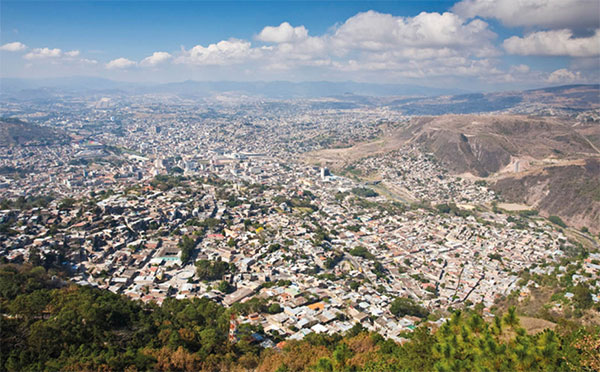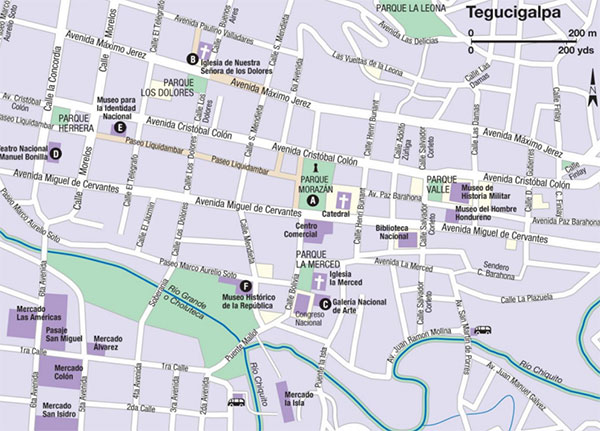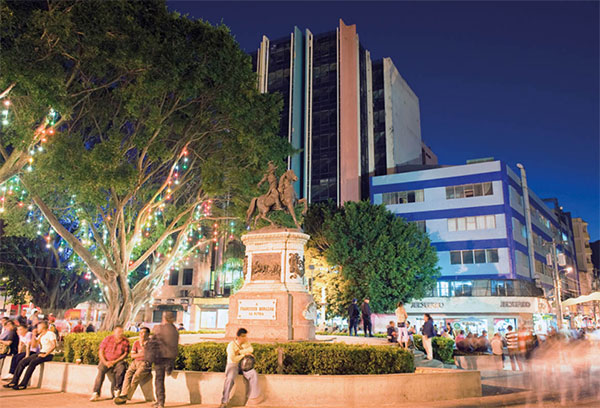Tegucigalpa and around
Founded on September 29, 1578, Tegucigalpa 1 [map] , sitting in a valley surrounded by mineral-rich hills, lingered in obscurity until 1880 when then president Marco Aurelio Soto moved the capital here from Comayagua. While the commercial center of the country has moved to San Pedro Sula, ‘Te-goose,’ as it’s sometimes called, remains the political and intellectual center of the country. While it lacks major attractions, Honduras’ best museums and cultural institutions are found here.

View of Tegucigalpa from above.
AWL Images
The city center
The colonial center of Tegucigalpa, a grid of 7 by 20 blocks, is at Parque Morazán A [map] , or Parque Central. On the square’s eastern edge is a baroque Cathedral, built between 1765 and 1782, that honors Saint Michael the Archangel, while the pedestrian-only Calle Peatonal leads west from the square, sided by clothing stores and inexpensive restaurants. A few blocks northwest is Iglesia de Nuestra Señora de los Dolores B [map] (daily 7am–noon and 3–6pm; free), dating to 1732 and featuring an impressive carved altar. On a small plaza beside the Iglesia la Merced is the Galería Nacional de Arte C [map] (tel: 2222 0250; Tue–Sun 9am–4pm), Honduras’ most important art museum. The museum, housed in a former convent, displays exhibits chronologically, from the art of pre-Mayan cultures to the religious art of the colonial period and modern paintings from contemporary artists like Pablo Zelaya Sierra.
At Parque Herrera, there’s the stunning Teatro Nacional Manuel Bonilla D [map] (www.facebook.com/TNManuelBonilla; Tue–Wed & Fri–Sat 10am–6pm, Thur & Sun 10am–9pm), which was modeled on Paris’ Plaza Athenée. The finest performing arts in the country, from opera to the ballet, are staged here throughout the year. Just up Avenida Barahona is the Museo para la Identidad Nacional E [map] (www.min.hn; Thur–Sat 9am–5pm, Sun 11am–4pm), which opened in 2006 in what was previously the Palace of Ministries. Honduran history is laid out from its pre-Columbian origins to modern times though photos, historical documents, and artifacts.

On Paseo Soto, inside the former Presidential palace, is the Museo Histórico de la República F [map] (Mon–Fri 8am–4pm), which focuses on the independence era, with exhibitions displaying portraits, documents, and other paraphernalia of past presidents.
Not a residential area and lacking hotels, the center seems deserted after dark and is best avoided.
Outside the center
The rest of the city spreads out to the south and east. Along Boulevard Morazán is Colonia Palmira and Colonia San Carlos, middle- and upper-class residential communities where many of the best hotels and restaurants can be found. Most tourist amenities such as embassies, airline offices, and travel agencies are located here as well. Near the boulevards of Juan Pablo II and Suyapa is the most modern part of the city, where many upscale residents live. The Multiplaza Mall complex, a North American-style shopping complex with international chain stores, is beside top hotels like the Intercontinental.
Farther east is Suyapa, a small town that was swallowed whole by Tegucigalpa’s urban sprawl. Most tourists come here to visit the Santuario Nacional and Basílica de Suyapa (grounds open daily, interior of the basilica only during mass) the largest cathedral in the country. At this gothic cathedral, the Virgin of Suyapa, famous throughout Honduras for its healing powers, is brought out for special events like the Feria de la Virgen de Suyapa.
Parque Nacional La Tigra
Twenty-two kilometers (14 miles) from Tegucigalpa is Parque Nacional La Tigra 2 [map] (daily 8am–5pm), a 238 sq km (92 sq miles) tract of cloud forest that has been a national park since 1982. While much of the forest was cut down by loggers and the El Rosario Mining Company, it is slowly being recovered. Hiking trails run through the park, mostly from the western entrance at Jutiapa, where there is a small campground, cabins, and a visitor center. The 6km (3.7 miles) Sendero Principal is the primary route across La Tigra, though a handful of other trails in various states of maintenance branch off it. Even though the park is so close to Tegucigalpa, it has a surprisingly rich collection of flora and fauna. Mammals like pumas and armadillos are rare, though more than 350 species of birds have been identified, including the resplendent quetzal and wine-throated hummingbird. The non-profit Amitigra (tel: 504 232 6771; www.amitigra.com) controls access to the park and can help make arrangements for visiting.

Equestrian statue of Franscisco Morazán in Plaza Morazán.
Robert Harding
Valle de Ángeles and Santa Lucía
On weekends, day trippers from Tegucigalpa head to a pair of colonial mountain villages east of the city. The first you will come to is Santa Lucía, where small rural inns, country restaurants, and nurseries are strung out along the road. Valle de Ángeles, 8km (5 miles) east of Santa Lucía, has a cooler climate and many wealthy capitalinos have houses here. The 16th-century village is filled with artesania shops selling items from every part of Honduras. While most items are from elsewhere in the country, jewelry made from silver and other metals that once came from the area’s mines are made locally. You’ll find better prices and variety here than in Tegucigalpa. There’s a good hike through the pine forests to the Las Golondrinas Waterfall, about 1km (0.6 miles) outside of town on the road to San Juancito.
Western Honduras
For many, the mountainous western region of Honduras is the real Honduras. As you move away from the urban sprawl of San Pedro Sula, cowboys and Indigenous groups like the Lenca and Chortí Maya have learned to coexist amidst the pine covered hills. Much of the cigar industry is based here, near Santa Rosa de Copán, and must see attractions like the ruins of Copán, the intellectual capital of the Mayas, and the breathtaking Lago de Yojoa, are here too.
San Pedro Sula
Many travelers tend to skip San Pedro Sula 3 [map] , the economic and transportation hub of Honduras, especially given its violent reputation of recent years. San Pedro lacks a connection to the past in the way Tegucigalpa does, as it lingered as a rural backwater until the 1920s when the United Fruit Company set up here. Today the population is around 700,000, making it the second largest conurbation in the country.